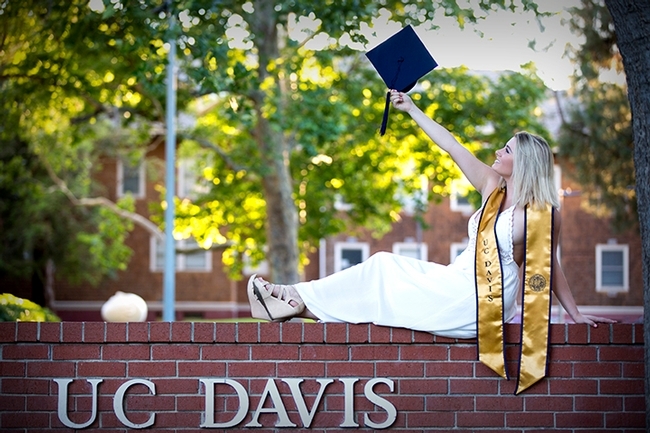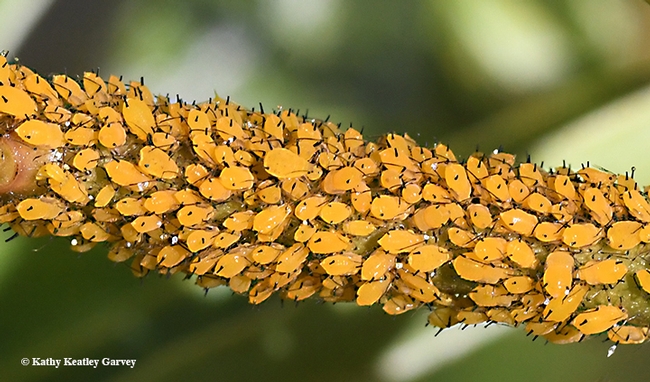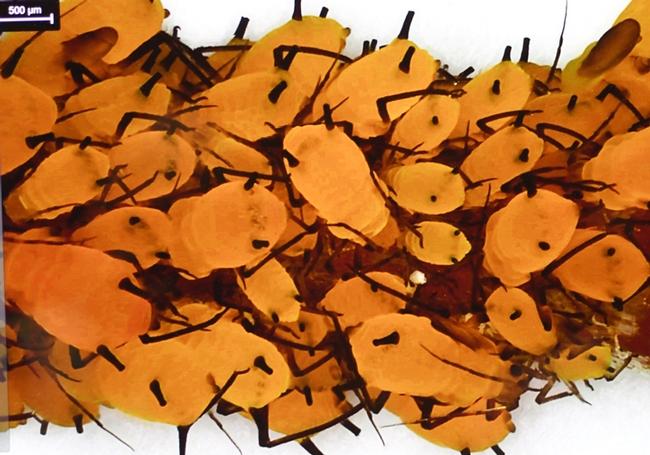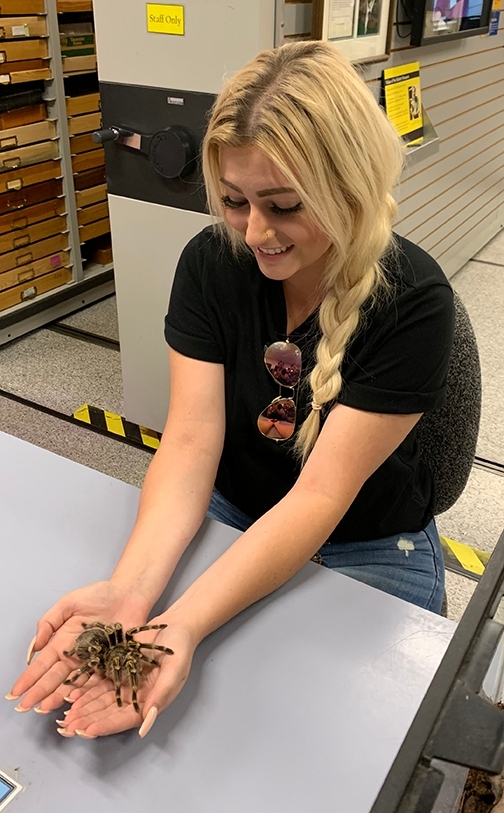- Author: Kathy Keatley Garvey
Andrea Guggenbickler, staff academic advisor for the Global Disease Biology (GBD) major, part of the UC Davis Department of Plant Pathology, has received a prestigious award for her outstanding advising.
The 2020 Eleanor and Harry Walker Academic Advising Awards program, College of Agricultural and Environmental Sciences (CA&ES), selected her for the staff academic advisor award.
Guggenbickler coordinates a 400-student program that includes course scheduling, faculty and instructional reports, statistical analysis of the major, and individual advising sessions.
“Andrea has made such a positive impact on student success in the GDB major,” said Susan Ebeler, CA&ES associate dean for undergraduate academic programs. "She has created innovative materials for incoming GDB students to support their remote advising experience and she is dedicated to student welfare and ensuring that the basic needs of every student are met.”
Nominator David Rizzo, professor and chair of the Department of Plant Pathology, described Andrea “as a huge part of the development of the relatively new Global Disease Biology major at UC Davis. Since becoming a GDB major, she has played many different roles in the major.”
And “all with her trademark enthusiasm,” he added.
The story behind the story....as a student majoring in GDB from 2014 to 2018 at UC Davis, Andrea appreciated the “incredible support” she received from then staff academic advisor Brandy Fleming. Now, in a scenario turned full circle, Andea is drawing appreciation from students and faculty for her own “incredible support.”
“Although she has been a staff advisor for a only a short period of time (since June 2019), Andrea has had a tremendous impact on the major,” wrote Rizzo in his nomination letter. Praising her leadership, dedication, communication skills and problem-solving expertise, he characterized her as a “truly a caring advisor” and someone with “an excellent sense of the needs of our students in order for them to be successful in the major.”
The Walker Academic Advising Awards recognize faculty, staff, and peer advisors who have demonstrated excellence and innovation in academic advising for CA&ES academic programs. The 2020 recipients also include Jim Fadel, faculty master advisor, Department of Animal Science and Management; and Kiara Cuevas, peer advisor for Agricultural and Environmental Education, Animal Science, and Animal Science and Management.
"It's so nice to see our hardworking advisors being recognized college-wide,” said Nora Orozco, chief administrative officer serving both departments. Last year Elvira Galvan Hack, staff advisor for animal biology (ABI), received the Walker staff award and forensic entomologist Robert Kimsey received the faculty master advisor award. They went on to win regional and international advising awards from NACADA, the global community for academic advising.
Andrea formerly served as an academic advising assistant to the animal biology and entomology majors, both housed in the Department of Entomology and Nematology.
“I've always believed in the power of advising,” said Guggenbickler, who received her bachelor's degree from UC Davis in 2018. “When I first met with the GDB advisor, Brandy Fleming (now an undergraduate academic advisor supporting majors in economics, history, and East Asian studies), she helped support me and my education in incredible ways. Since then, I've wanted to do the same thing for others. As a (student) peer advisor, I was able to connect with students based on shared experiences, which has been extremely valuable in my current position as well. Now, as a staff advisor I've tried to use my position to be a constant advocate for the students. I do my best to always put their needs first, and to do whatever I can to help students in difficult situations.”
“One of the main ways I've tried to make a difference in our advising center is to create our student pantry,” Andrea said. “We provide healthy, easily accessible, snacks and on-the-go food and drinks for students. Food insecurity can be a huge issue for students, and we have done our best to mitigate that barrier for them. The pantry is open to everyone, and we have gotten some really great feedback from students who have said that it has really helped them. Getting that feedback and tangibly making a difference has been by far one of the most rewarding parts of my job.”
Her favorite part of being an advisor? “Watching students succeed. I've been with the program in some capacity since 2017, so I've seen a lot of students come through the office. I make an effort to meet with every student at least once per year, and it is amazing seeing them grow, conquer obstacles, excel in coursework, graduate, and move on to their next adventure.”
“Advisors have a really unique opportunity to touch a lot of lives in a meaningful way,” Andrea said. “I can only hope that in my time as an advisor at UC Davis that I've been able to create a positive change in the lives of others the same way that my students have made a positive change in my life. As I move on to my next adventure as a master of public health student I will take with me the lessons my students have taught me: the importance of equity, advocacy, belief in oneself, and perseverance. I am thankful to the advising community in the College of Ag for creating a space in which advisors are able to make a difference for students while also growing themselves.”
Andrea grew up in Ferndale, Humboldt County, and now lives in Woodland with her fiancé, Tyler Baum, an associate veterinarian at Broadway Veterinary Hospital, Sacramento. Baum, a “double” UC Davis alumnus, holds a bachelor's degree in animal science and a DVM from the School of Veterinary Medicine. They share their home with three UC Davis-connected cats: “Butters,” “Toast” and “Dr. Professor Stripey Pants.”
"We got Butters and Stripey (they are brothers) from the Orphan Kitten Project run through the Vet School," she said, "and we got Toast from a shelter when Tyler did a shelter medicine rotation--and he fell in love with her and brought her home."
The couple purposely selected "breakfast names" for Butters, a light orange tabby and Toast, a black and white feline, but they couldn't bear to change the name of Dr. Professor Stripey Pants, a gray tabby ("it was too perfect").
Her career plans? “My career plans are to complete my master's degree in public health, and hopefully pursue my Ph.D in public health. After that I would love to dive into public health research and advocacy for women and minority health. Ideally, in the future, I would like to do some teaching at the collegiate level.”
Rizzo says that GDB is now the fifth largest major in the CA&ES, but it still maintains the “small-college” feel. Among Andrea's many accomplishments: modifying and expanding the department's professional development modules. “Over the holiday break, she developed a series of orientation modules (seven in total) within Canvas,” he wrote. “All in all, the whole project is amazing. And it was done without dropping the ball with any of her traditional advising.”
As a facilitator with First-Year Aggie Connections, Guggenbickler mentors students as they navigate their first-year experience. She created a 10-week course on professional development that encompasses such topics as “how to read a scientific paper” and “how to create a resume.”
In a group letter, GDB students Austin Dalmasso, Bianca Arao and Brandon Nguyen, all who worked as either peer mentors or peer advisors, praised her dedication and accomplishments.
“As the academic advisor, she communicates efficiently with students when they need to speak to her regarding urgent or sensitive circumstances, and when she is with students, she is attentive and sensible to any situations that may need care beyond her scope,” they wrote. “Andrea cares about her students and wants to equip them for success in their future endeavors.”
“Throughout all of the responsibilities that govern an academic advisor's role, Andrea is always looking for novel ways to improve student advising,” they wrote. “As students, we look back on our own informative orientations, and praise Andrea for making this year's orientation user-friendly.”
“From the countless interactions we have shared with Andrea, we are grateful that she always puts it upon herself to be an open crisis line. Andrea is genuinely supportive of our successes as students, and continues to be a comforting figure we greatly appreciate. It is Andrea's nurturing character that we want to honor and showcase to the UC Davis community.”

- Author: Kathy Keatley Garvey

Especially those oleander aphids that suck the very lifeblood out of our milkweed plants that we're struggling to save for monarch butterflies.
Just call aphids "The Enemy of the Gardener" or "The Enemy of the Milkweed."
The University of California Statewide Integrated Pest Management Program (UC IPM) describes aphids as "small, soft-bodied insects with long slender mouthparts that they use to pierce stems, leaves, and other tender plant parts and suck out fluids. Almost every plant has one or more aphid species that occasionally feed on it."
"Aphids have soft pear-shaped bodies with long legs and antennae and may be green, yellow, brown, red, or black depending on the species and the plants they feed on," UC IPM tells us. "A few species appear waxy or woolly due to the secretion of a waxy white or gray substance over their body surface. Most species have a pair of tubelike structures called cornicles projecting backward out of the hind end of their body. The presence of cornicles distinguishes aphids from all other insects.
"Generally adult aphids are wingless, but most species also occur in winged forms, especially when populations are high or during spring and fall. The ability to produce winged individuals provides the pest with a way to disperse to other plants when the quality of the food source deteriorates."
Not only do aphids stunt plant growth but they can spread viruses. Plus, they produce that sticky honey dew they that attracts ants and other insects.
Density? We've seen aphids so dense on our milkweed stems that all we see is yellow. (Sometimes we see red!)
We recently saw them magnified on a Leica DVM6 microscope, operated by Lynn Epstein, UC Davis emeritus professor of plant pathology, at a demonstration in Hutchison Hall. (See image below)
In California, most aphids reproduce asexually throughout most of the year, according to UC IPM. Did you know that a single aphid can generate as many as 12 offspring a day--without mating?
Bring on the lady beetles (aka lady bugs), lacewings, and soldier beetles! The larvae of lady beetles and syrphid flies also do their part in gobbling up aphids.
What to do when biological control doesn't work that well? Or when your lady beetles depart? Pinch the aphids; spray them with with water; or spray them with a mixture of 1 tablespoon of dish soap (Castile liquid soap) and one quart of water. Some folks dab aphids with cotton swabs dipped in isopropyl (rubbing) alcohol but that will kill the monarch eggs and larvae as well. We've found that spraying a mixture of sudsy soap and water works best for us.
Lather is the best medicine.





